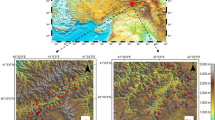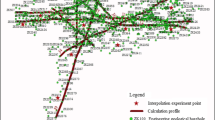Abstract
The inverse-distance weighting (IDW) method is considered as one of the most popular deterministic methods and is widely applied to a variety of areas because of its low computational cost and easy implementation. In this paper, we show that the classical IDW is essentially a zeroth-order local kernel regression method with an inverse distance weight function. Thus, it suffers from various shortcomings, such as the boundary bias. Considering the advantages of the local polynomial modeling technique in statistics, the classical IDW was generalized into a higher-order regression by the Taylor expansion and then computed by means of a weighted least-squares method. Surface modeling of rainfall fields in China indicated that the generalized IDWs with the first- and second-orders are more accurate than the classical IDW in terms of root mean square error (RMSE). The example of digital elevation model construction with a group of sample points showed that the two generalized IDWs have better RMSE and mean error than the classical IDW. Furthermore, the second-order IDW has a better performance than the ordinary kriging in terms of RMSE. A theoretical analysis demonstrated that the gradient-plus-inverse distance squared method presented by Nalder and Wein (Agric For Meteorol 92(4): 211–225, 1998) is a first-order form of the generalized IDW expanded on spatial coordinates and elevation. In a word, the generalized IDW can incorporate multiple covariates, which can better explain the interpolation procedure and might improve its accuracy.






Similar content being viewed by others
References
Babak O, Deutsch C (2009) Statistical approach to inverse distance interpolation. Stoch Env Res Risk A 23(5):543–553
Boman G, Molz F, Guven O (1995) An evaluation of interpolation methodologies for generating three-dimensional hydraulic property distributions from measured data. Ground Water 33(2):247–258
Brus DJ, Gruijter JJD, Marsman BA, Visschers R, Bregt AK, Breeuwsma A, Bouma J (1996) The performance of spatial interpolation methods and choropleth maps to estimate properties at points: a soil survey case study. Environmetrics 7(1):1–16
Burrough PA, McDonnell RA (1998) Principles of geographical information systems. Oxford University Press, New York, p 220
Cai Z (2001) Weighted Nadaraya–Watson regression estimation. Stat Probabil Lett 51(3):307–318
Chang C-L, Lo S-L, Yu S-L (2006) The parameter optimization in the inverse distance method by genetic algorithm for estimating precipitation. Environ Monit Assess 117(1–3):145–155
Chen CF, Yue TX (2010) A method of DEM construction and related error analysis. Comput Geosci-uk 36(6):717–725
Cleveland WS, Devlin SJ, Grosse E (1988) Regression by local fitting: methods, properties, and computational algorithms. J Econ 37(1):87–114
de Mesnard L (2013) Pollution models and inverse distance weighting: some critical remarks. Comput Geosci-uk 52:459–469
Delbari M (2014) Accounting for exhaustive secondary data into the mapping of water table elevation. Arab J Geosci 7(10):4221–4233
Efron B, Hastie T, Johnstone I, Tibshirani R (2004) Least angle regression. Ann Stat 32(2):407–499
El Bastawesy M (2014) The geomorphological and hydrogeological evidences for a Holocene deluge in Arabia. Arab J Geosci 1–10
Falivene O, Cabrera L, Tolosana-Delgado R, Sáez A (2010) Interpolation algorithm ranking using cross-validation and the role of smoothing effect. A coal zone example. Comput Geosci-uk 36(4):512–519
Fan J, Gijbels I (1996) Local polynomial modelling and its applications. CRC Press, London, p 328
Fisher PF (1992) First experiments in viewshed uncertainty: simulating fuzzy viewsheds. Photogramm Eng Remote Sense 58:345
Fisher PF, Tate NJ (2006) Causes and consequences of error in digital elevation models. Prog Phys Geogr 30(4):467–489
Fotheringham A, Brunsdon C, Charlton M (2002) Geographically weighted regression: the analysis of spatially varying relationships. Wiley, Chichester, p 284
Gallichand J, Marcotte D (1993) Mapping clay content for subsurface drainage in the Nile Delta. Geoderma 58(3–4):165–179
Greenberg JA, Rueda C, Hestir EL, Santos MJ, Ustin SL (2011) Least cost distance analysis for spatial interpolation. Comput Geosci-uk 37(2):272–276
Hastie T, Loader C (1993) Local regression: automatic kernel carpentry. Stat Sci 8:120–129
Khashei-Siuki A, Sarbazi M (2013) Evaluation of ANFIS, ANN, and geostatistical models to spatial distribution of groundwater quality (case study: Mashhad plain in Iran). Arab J Geosci 7(10):4175–4190
Kravchenko AN (2003) Influence of spatial structure on accuracy of interpolation methods. Soil Sci Soc Am J 67(5):1564–1571
Lloyd CD (2005) Assessing the effect of integrating elevation data into the estimation of monthly precipitation in Great Britain. J Hydrol 308(1–4):128–150
Lu YG, Wong DW (2008) An adaptive inverse-distance weighting spatial interpolation technique. Comput Geosci-uk 34(9):1044–1055
Merwade VM, Maidment DR, Goff JA (2006) Anisotropic considerations while interpolating river channel bathymetry. J Hydrol 331(3–4):731–741
Moore ID, Grayson RB, Ladson AR (1991) Digital terrain modelling: a review of hydrological, geomorphological, and biological applications. Hydrol Process 5(1):3–30
Nalder IA, Wein RW (1998) Spatial interpolation of climatic Normals: test of a new method in the Canadian boreal forest. Agric For Meteorol 92(4):211–225
Oliver MA, Webster R (1990) Kriging: a method of interpolation for geographical information systems. Int J Geogr Inf Sci 4(3):313–332
Robertson GP (2008) Geostatistics for environmental sciences, GS + users guide, version 5. Gamma Design Software, Plainwell, p 200
Shahbeik S, Afzal P, Moarefvand P, Qumarsy M (2014) Comparison between ordinary kriging (OK) and inverse distance weighted (IDW) based on estimation error. Case study: Dardevey iron ore deposit, NE Iran. Arab J Geosci 7(9):3693–3704
Shiode N, Shiode S (2011) Street-level spatial interpolation using network-based IDW and ordinary kriging. Trans GIS 15(4):457–477
Tomczak M (1998) Spatial interpolation and its uncertainty using automated anisotropic inverse distance weighting (IDW)-cross-validation/jackknife approach. J Geogr Inf Decis Anal 2(2):18–30
Van Niel TG, McVicar TR, Li L, Gallant JC, Yang Q (2008) The impact of misregistration on SRTM and DEM image differences. Remote Sens Environ 112(5):2430–2442
Wakode H, Dutta D, Desai VR, Baier K, Azzam R (2013) Morphometric analysis of the upper catchment of Kosi River using GIS techniques. Arab J Geosci 6(2):395–408
Wang N, Mei CL, Yan XD (2008) Local linear estimation of spatially varying coefficient models: an improvement on the geographically weighted regression. Environ Plan A 40:986–1005
Weber D, Englund E (1992) Evaluation and comparison of spatial interpolators. Math Geol 24(4):381–391
Zhou J, Sha Z (2013) A new spatial interpolation approach based on inverse distance weighting: case study from interpolating soil properties. In: Bian F, Xie Y, Cui X, Zeng Y (eds) Geo-informatics in resource management and sustainable ecosystem. Communications in computer and information science. Springer, Berlin, pp 623–631
Acknowledgments
The 1-km SRTM data used in this paper were provided by Environmental and Ecological Science Data Center for West China, National Natural Science Foundation of China (http://westdc.westgis.ac.cn). This work is supported by National Natural Science Foundation of China (Grant No. 41101433, 41371367), by Young and Middle-Aged Scientists Research Awards Fund of Shangdong Province (Grant No. BS2012HZ010), by Qingdao Science and Technology Program of Basic Research Project (Grant No. 13-1-4-239-jch), by the Key Laboratory of Marine Surveying and Mapping in Universities of Shandong (Shandong University of Science and Technology) (Grant No. 2013B03), by SDUST Research Fund, and by Joint Innovative Center for Safe and Effective Mining Technology and Equipment of Coal Resources.
Author information
Authors and Affiliations
Corresponding author
Rights and permissions
About this article
Cite this article
Chen, C., Zhao, N., Yue, T. et al. A generalization of inverse distance weighting method via kernel regression and its application to surface modeling. Arab J Geosci 8, 6623–6633 (2015). https://doi.org/10.1007/s12517-014-1717-z
Received:
Accepted:
Published:
Issue Date:
DOI: https://doi.org/10.1007/s12517-014-1717-z




